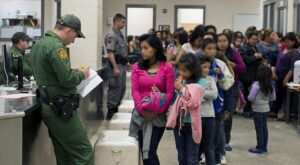
Amid the huge internal and international displacement of millions of Ukrainians after their country was invaded by Russia in February 2022, the United States is extending protection to as many as 180,000. In what has become Europe’s largest humanitarian crisis since World War II, nearly 8 million Ukrainians have been internally displaced and more than 6 million civilians (predominantly women and children) have fled the country—the vast majority seeking refuge in neighboring Poland, Moldova, Romania, Hungary, and Slovakia.
The Biden administration’s actions to welcome some Ukrainians began on March 3, when Homeland Security Secretary Alejandro Mayorkas announced the grant of Temporary Protected Status (TPS) for 18 months for certain Ukrainians already present in the United States. The Department of Homeland Security (DHS) estimated that 59,600 Ukrainians would be eligible for the program, which provides relief from deportation and work authorization. On April 21, the administration announced plans to welcome up to 100,000 Ukrainians through a combination of the Uniting for Ukraine program—a private sponsorship program that aims to temporarily bring displaced Ukrainians to the United States—and other, more permanent entry pathways. In more ad hoc fashion, the U.S. government admitted a reported 20,000 Ukrainians who arrived at the U.S.-Mexico border without authorization to enter; the practice was ended in late April.
The new Ukrainian arrivals are joining an existing Ukrainian diaspora in the United States that numbers more than 1.1 million. The Ukrainian diaspora includes close to 355,000 immigrants from Ukraine, who account for about 1 percent of the total 44.9 million immigrants living in the United States as of 2019. Beyond the 355,000 immigrants, the Ukrainian diaspora in the United States is comprised of people born in the United States or other countries who claim Ukrainian ancestry.
This article focuses on the population of Ukrainian immigrants in the United States pre-invasion of Ukraine, using the 2019 American Community Survey (ACS), which is the most recent comprehensive dataset available from the U.S. Census Bureau given pandemic-related data-collection difficulties for the 2020 ACS.
Ukrainians began migrating to the United States in the late 19th century over successive waves. An estimated 254,000 arrivals who came between 1899 and 1914 consisted mainly of agricultural laborers seeking economic and employment opportunities. Many initially settled on the East coast but gradually moved to Midwestern states such as Ohio and North Dakota. About 12,000 largely high educated and urban Ukrainians who fought for Ukrainian independence during a war with the Soviet Union between 1917 and 1921 left for the United States following defeat. The destruction caused by World War II led to another significant exodus of Ukrainians: About 80,000 migrated to the United States between 1947 and 1955, when the Soviet government restricted most forms of emigration.
After the collapse of the Soviet Union in 1991, Ukrainians were able to emigrate again, and 108,000 moved to the United States between 1992 and 1997. Many were economic and family migrants; others, for example Evangelical Christians and Jews, were beneficiaries of the Lautenberg Program that allows nationals of former Soviet republics to immigrate through the refugee resettlement program on grounds of religious persecution. The program is a key reason why more than 1,900 Ukrainians were granted refugee status in the United States in 2020, making them the third largest number of resettled refugees that year after nationals from the Democratic Republic of the Congo and Myanmar.
As of 2019, an estimated 355,000 Ukrainian immigrants lived in the United States, a nearly one-third increase over the 275,000 who were in the country as of 2000.
The United States is now home to the second largest Ukrainian population in the world, outnumbered by Russia (3,268,000), according to mid-2020 estimates from the United Nations Population Division (UNDP). The Ukrainian immigrant population in Kazakhstan is similar in size to the U.S. one. (Note: Russia and Kazakhstan were once part of the Soviet Union along with Ukraine. The high number of Ukrainian-born persons in Russia and Kazakhstan reflects both internal migration during the Soviet era and international migration after the former Soviet republics became independent nations.) Large numbers of Ukrainians Most Ukrainian immigrants in the United States are naturalized U.S. citizens and most gain legal permanent residence status either through family sponsorship or admittance via refugee and asylum channels. Compared to the overall U.S. immigrant population, Ukrainians have higher incomes and higher levels of educational attainment while experiencing lower levels of poverty.
Using data from the U.S. Census Bureau (the 2019 ACS as well as pooled 2015-19 ACS data), the Department of Homeland Security’s 2020 Yearbook of Immigration Statistics, and World Bank annual remittance data, this Spotlight provides information on the Ukrainian immigrant population in the United States, focusing on its size, geographic distribution, and socioeconomic characteristics.
also resided in Germany (290,000), Poland (273,000), and Italy (248,000) as of the 2020 UNDP estimates.











































